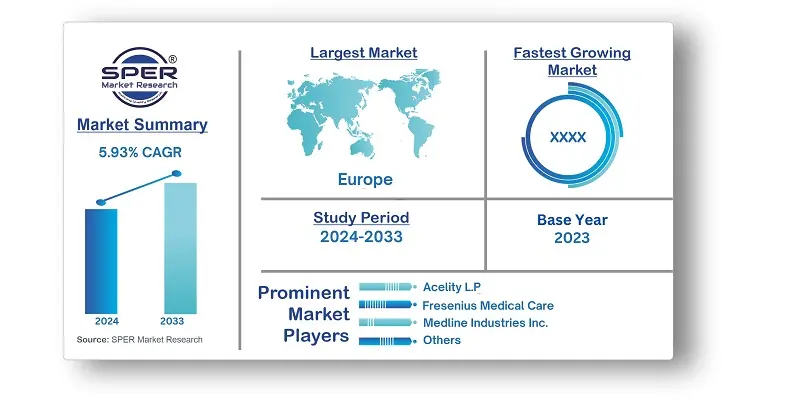
Germany Home Healthcare Market Growth, Size, Trends, Demand, Revenue and Future Outlook
Germany Home Healthcare Market Size- By Type, By Products- Regional Outlook, Competitive Strategies and Segment Forecast to 2033
| Published: Jun-2024 | Report ID: HLCA2462 | Pages: 1 - 103 | Formats*: |
| Category : Healthcare | |||
- NxStage Medical, Inc. was purchased by Fresenius Medical Care in 2019 in an effort to improve its market share in the home hemodialysis machine industry.
- A definitive deal to acquire Maxim Healthcare Service's home health care segment was signed in 2019 by Aveanna Healthcare, based in Atlanta.


| Report Metric | Details |
| Market size available for years | 2020-2033 |
| Base year considered | 2023 |
| Forecast period | 2024-2033 |
| Segments covered | By Type, By Products |
| Regions covered | Eastern Region, Western Region, Southern Region, Northern Region |
| Companies Covered | Acelity L.P, Fresenius Medical Care, Medline Industries Inc., Hollister Inc., B. Barun melsungen AG, ConvaTec Group plc, Molnlycke Health Care, Others. |
- Elderly Population
- Individuals with Chronic Illnesses
- Patients Recovering from Surgery or Injury
- People with Disabilities
- Busy Families in Need of Convenient Care
| By Type: |
|
| By Product: |
|
- Germany Home Healthcare Market Size (FY’2024-FY’2033)
- Overview of Germany Home Healthcare Market
- Segmentation of Germany Home Healthcare Market By Type (Devices, Diagnostic, Mobility Assist, Services, Skilled Nursing, Software, Therapeutics, Unskilled Nursing)
- Segmentation of Germany Home Healthcare Market By Product (Therapeutic Products, Testing, Screening and Monitoring Products, Mobility Care Products)
- Expansion Analysis of Germany Home Healthcare Market
- Problems and Obstacles in Germany Home Healthcare Market
- Competitive Landscape in the Germany Home Healthcare Market
- Impact of COVID-19 and Demonetization on Germany Home Healthcare Market
- Details on Current Investment in Germany Home Healthcare Market
- Competitive Analysis of Germany Home Healthcare Market
- Prominent Players in the Germany Home Healthcare Market
- SWOT Analysis of Germany Home Healthcare Market
- Germany Home Healthcare Market Future Outlook and Projections (FY’2024-FY’2033)
- Recommendations from Analyst
1.1. Scope of the report1.2. Market segment analysis
2.1. Research data source2.1.1. Secondary Data2.1.2. Primary Data2.1.3. SPER’s internal database2.1.4. Premium insight from KOL’s2.2. Market size estimation2.2.1. Top-down and Bottom-up approach2.3. Data triangulation
4.1. Driver, Restraint, Opportunity and Challenges analysis4.1.1. Drivers4.1.2. Restraints4.1.3. Opportunities4.1.4. Challenges4.2. COVID-19 Impacts of the Germany Home Healthcare Market
5.1. SWOT Analysis5.1.1. Strengths5.1.2. Weaknesses5.1.3. Opportunities5.1.4. Threats5.2. PESTEL Analysis5.2.1. Political Landscape5.2.2. Economic Landscape5.2.3. Social Landscape5.2.4. Technological Landscape5.2.5. Environmental Landscape5.2.6. Legal Landscape5.3. PORTER’s Five Forces5.3.1. Bargaining power of suppliers5.3.2. Bargaining power of buyers5.3.3. Threat of Substitute5.3.4. Threat of new entrant5.3.5. Competitive rivalry5.4. Heat Map Analysis
6.1. Germany Home Healthcare Market Manufacturing Base Distribution, Sales Area, Product Type6.2. Mergers & Acquisitions, Partnerships, Product Launch, and Collaboration in Germany Home Healthcare Market
7.1. Germany Home Healthcare Market Size, Share and Forecast, By Type, 2020-20267.2. Germany Home Healthcare Market Size, Share and Forecast, By Type, 2027-20337.3. Devices7.4. Diagnostic7.5. Mobility Assist7.6. Services7.7. Skilled Nursing7.8. Software7.9. Therapeutics7.10. Unskilled Nursing
8.1. Germany Home Healthcare Market Size, Share and Forecast, By Product, 2020-20268.2. Germany Home Healthcare Market Size, Share and Forecast, By Product, 2027-20338.3. Therapeutic Products8.4. Testing, Screening and Monitoring Products8.5. Mobility Care Products
9.1. Germany Home Healthcare Market Size and Market Share
10.1. Germany Home Healthcare Market Size and Market Share By Region (2020-2026)10.2. Germany Home Healthcare Market Size and Market Share By Region (2027-2033)10.3. Eastern Region10.4. Western Region10.5. Southern Region10.6. Northern Region
11.1. Acelity L.P11.1.1. Company details11.1.2. Financial outlook11.1.3. Product summary11.1.4. Recent developments11.2. Fresenius Medical Care11.2.1. Company details11.2.2. Financial outlook11.2.3. Product summary11.2.4. Recent developments11.3. Medline Industries Inc.11.3.1. Company details11.3.2. Financial outlook11.3.3. Product summary11.3.4. Recent developments11.4. Hollister Inc.11.4.1. Company details11.4.2. Financial outlook11.4.3. Product summary11.4.4. Recent developments11.5. B. Barun melsungen AG11.5.1. Company details11.5.2. Financial outlook11.5.3. Product summary11.5.4. Recent developments11.6. ConvaTec Group plc11.6.1. Company details11.6.2. Financial outlook11.6.3. Product summary11.6.4. Recent developments11.7. Molnlycke Health Care11.7.1. Company details11.7.2. Financial outlook11.7.3. Product summary11.7.4. Recent developments11.8. Others
SPER Market Research’s methodology uses great emphasis on primary research to ensure that the market intelligence insights are up to date, reliable and accurate. Primary interviews are done with players involved in each phase of a supply chain to analyze the market forecasting. The secondary research method is used to help you fully understand how the future markets and the spending patterns look likes.
The report is based on in-depth qualitative and quantitative analysis of the Product Market. The quantitative analysis involves the application of various projection and sampling techniques. The qualitative analysis involves primary interviews, surveys, and vendor briefings. The data gathered as a result of these processes are validated through experts opinion. Our research methodology entails an ideal mixture of primary and secondary initiatives.



Frequently Asked Questions About This Report
PLACE AN ORDER
Year End Discount
Sample Report
Pre-Purchase Inquiry
NEED CUSTOMIZATION?
Request CustomizationCALL OR EMAIL US
100% Secure Payment






Related Reports
Our Global Clients
Our data-driven insights have influenced the strategy of 200+ reputed companies across the globe.




















